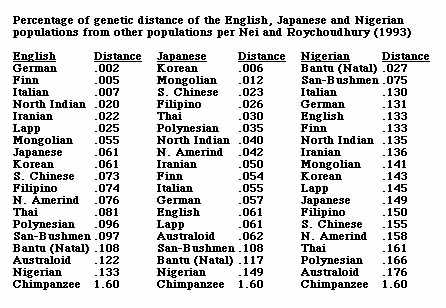RiverF wrote:Galaxian wrote:.......
Here's a more concise & easier to read genetic distance table:


That's a pretty awesome list .. thanks for posting.
What if we took a single progeny of each one of those listed groups, sent them on a randomly matched holiday where they hooked up with someone from one of the other listed groups and produced a child ... How would you categorise each child from those matches?
And if we were to take those children and do the same, what categories would you list their offspring as?
And are we still defining these generations as subspecies? Is there a point over such mixed generations where we discontinue doing so? If not, why not?
Thank you for your compliment, it far more than I usually get

If one of those subspecies was matched with one of another, the context would be important:
a) They could simply be put in the same holiday camp, in which case, depending on their genetic distance, they could probably ignore each other.
b) They could be forced to copulate, in which case they may or may not conceive depending on their genetic distance. See my earlier post about 3rd cousins being the most fecund.
As to the offspring. Depending on the genetic discrepancy, they would have different degrees of fitness. At one extreme; if one parent was Rh+ & the other Rh- and the mother was antagonistic to the fetus, the fetus would likely die or be sickly. By the 2nd baby, the fetus would almost certainly die. At the other extreme, if the genetic distance is moderate we could have hybrid vigor, that is, increased fitness, due to lessening of detrimental recessive genes.
The surviving children would have different degrees of fertility, again depending on the specific mix of subspecies. But in due course, as I said earlier, the compatible subspecies would become one subspecies.
That is, if they are forced into unions over generations. The instant that forced intermixing stops, new subspecies will spontaneously begin to emerge (over many generations), due to natural attraction of some people for some & repulsion from some others, that is gradually reinforced as differences multiply. So, early hominins still cross-bred with early chimps, but as they diverged that interaction disappeared & was replaced by revulsion.
The emergence of subspecies & then species is due to unstable selection pressures in biological systems. It is like a big ball on top of a hill, it will begin to roll one way or other. As it descends, it can not re-climb the hill & decide to take a different path. That's why the eye (for example) is such a messy contrivance; the development had to be layered on top of what had gone before. It could not undo previous planning easily.
That is also why we have convergent evolution, such as the body form of sharks & dolphins. But we would not mistake one for the other. That is why different organisms develop along different trajectories & inhabit different niches in the ecology. If accidental & spontaneous divergence did not exist, then every creature would be identical since they would be impelled by identical environmental forces.

